Key takeaways:
- A photography portfolio is a curated representation of an artist’s unique vision and style, requiring careful selection of images that resonate emotionally with viewers.
- An online presence is essential for photographers, serving as a calling card that connects them with potential clients and showcases their evolving work.
- Choosing the right platform for a portfolio impacts how work is perceived, with considerations for aesthetics, functionality, and community engagement being crucial.
- Effective portfolio promotion involves using social media, networking, and collaborations to reach a broader audience and enhance credibility within the photography community.
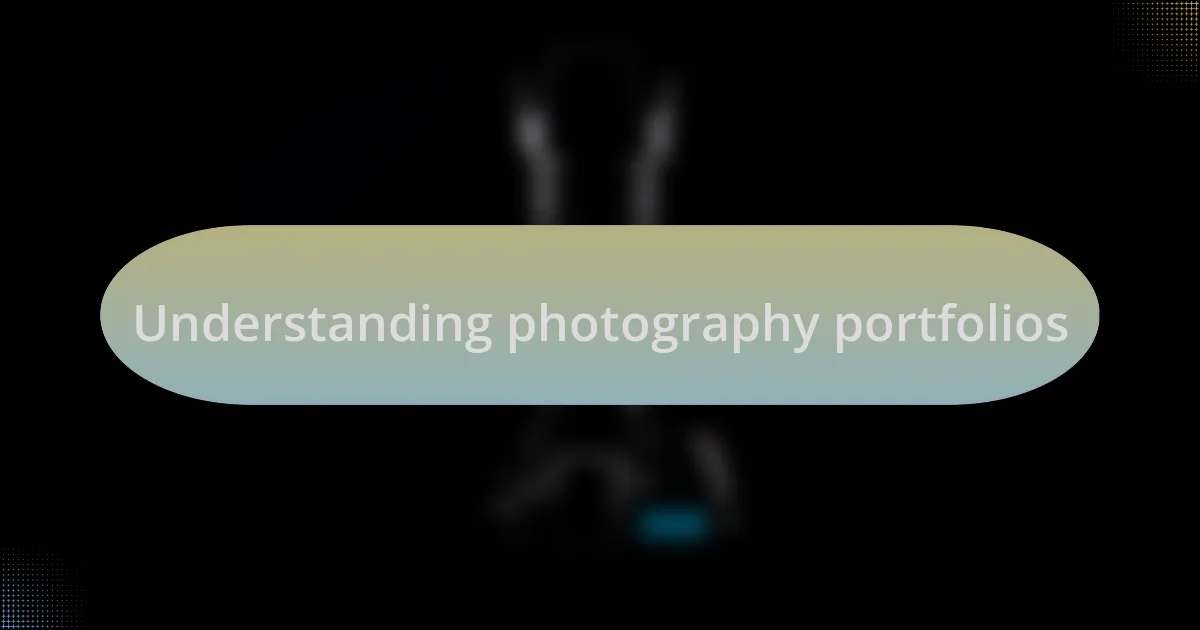
Understanding photography portfolios
A photography portfolio is more than just a collection of images; it’s a curated representation of your unique vision and style. I remember sifting through my own early work, feeling proud yet overwhelmed. How do you choose which pieces resonate most with your artistic identity? It’s a tough but essential question.
Selecting the right images for your portfolio requires critical self-reflection and honesty. I often found myself torn between showcasing technically impressive shots and those that carried emotional weight. Have you thought about which images truly tell your story? The most impactful portfolios often feature work that connects with viewers on a deeper level, making them feel something significant.
In my experience, organization is key to building a cohesive portfolio. I learned that grouping images by theme or style can create a narrative flow that guides the viewer’s experience. Have you ever considered how the order of your images affects their impact? Crafting that journey not only strengthens your portfolio but also leaves a lasting impression on potential clients and collaborators.
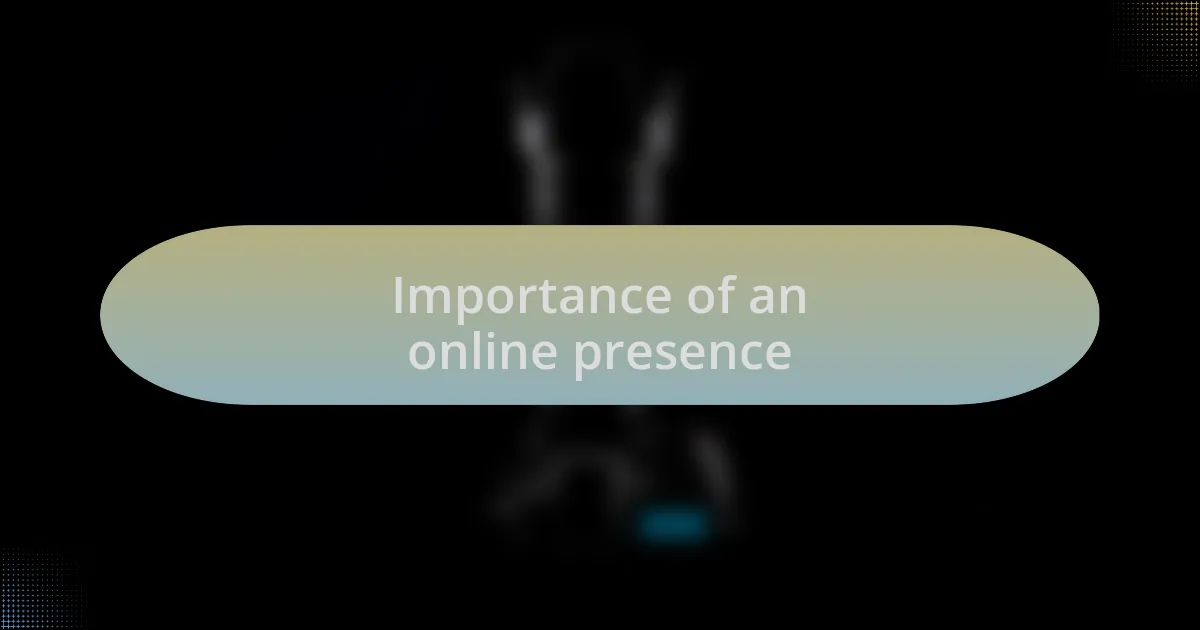
Importance of an online presence
Having an online presence is crucial for any photographer. When I first started sharing my work online, I realized it was more than just uploading images; it was about connecting with an audience. Have you ever wondered how visibility can transform your photography career? The internet opens doors to potential clients, collaborators, and a community that can provide valuable feedback.
In today’s digital age, your online portfolio serves as your calling card. I recall the excitement of receiving my first inquiry through my website after sharing my portfolio on social media. It made me realize that a well-crafted online presence can lead to opportunities I wouldn’t have otherwise encountered. Can you imagine the impact that sharing your unique style could have on someone searching for a fresh perspective in photography?
Moreover, an online presence allows for continuous growth and evolution. I often update my portfolio, showcasing my latest work and reflecting my growth as an artist. This keeps my audience engaged and shows that I’m constantly honing my craft. How often do you revisit your online presence to ensure it accurately represents who you are as a photographer? An evolving online portfolio can truly keep the conversation alive with your audience.
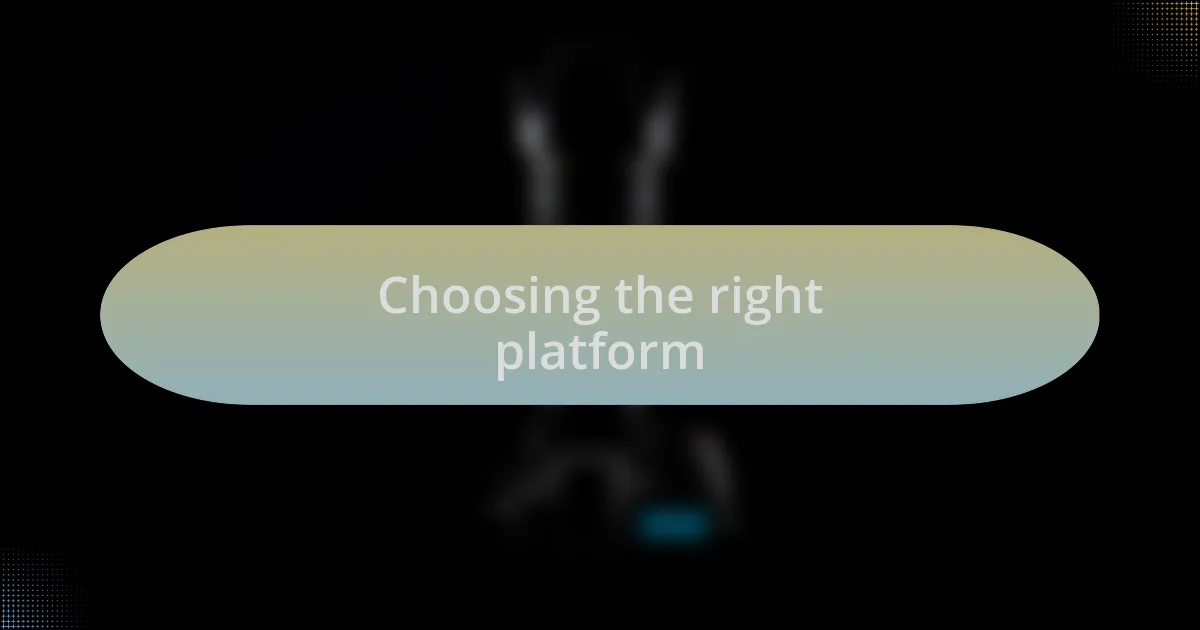
Choosing the right platform
Choosing the right platform for your photography portfolio can significantly impact how your work is perceived. When I was deciding where to showcase my images, I felt overwhelmed by the options. Each platform had its unique strengths; some offer stunning gallery layouts, while others are more user-friendly. Have you ever felt torn between aesthetics and functionality? I know I have, and ultimately, I chose a platform that struck a balance between both.
As I explored different platforms, I realized that the hosting features were crucial as well. Some platforms allow custom domain names, which can lend a more professional feel to your work. I remember registering my domain and how it gave me a sense of ownership. It felt like constructing my little corner of the internet. Think about how a personalized domain could enhance your credibility as a photographer.
Moreover, consider the community aspect of the platform you choose. I was drawn to one particular site because of its active forum, where photographers exchanged advice and critiques. That space has been invaluable for my growth, as I’ve learned so much from others’ perspectives. Wouldn’t you agree that being part of an engaged community can push your creativity to new heights? The right platform doesn’t just showcase your work; it also connects you with like-minded individuals who can inspire and challenge you.
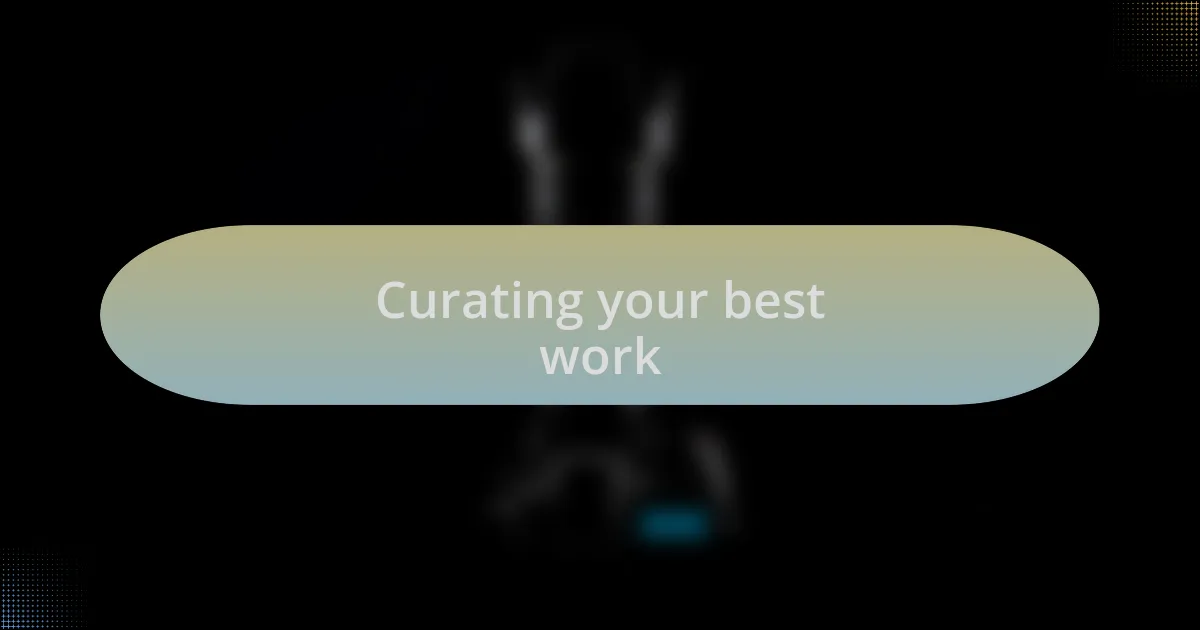
Curating your best work
Selecting the images for my portfolio was a profound moment. I remember sitting on my couch, scrolling through thousands of photos, trying to capture the essence of my journey. The process made me question which pieces genuinely resonated with my artistic voice. Have you ever found it hard to let go of certain photos, even if they didn’t quite fit the narrative you wanted to portray? In the end, I narrowed it down to those that not only showcased my technical skills but also stirred emotions within me.
I also learned that variety is essential, but consistency is key. In my experience, it was crucial to present a cohesive style. When I picked images that shared a common theme—such as my fascination with natural light—it created a solid foundation for my portfolio. This thought process pushed me to really think about how I wanted my work to be perceived. Do you think having a signature style can elevate your portfolio? I’ve seen firsthand how it allows potential clients or collaborators to instantly understand your artistic identity.
As I continued refining my selections, I paid attention to the stories behind each photo. Each image has its own tale, and incorporating that narrative adds depth to my portfolio. I vividly recall the day I captured a breathtaking sunset over the ocean, not just for the beauty but for the emotion of that moment—a reminder of resilience during a challenging time. Do you share your stories along with your images? I find that including them offers a captivating layer, engaging the viewer on a more personal level.
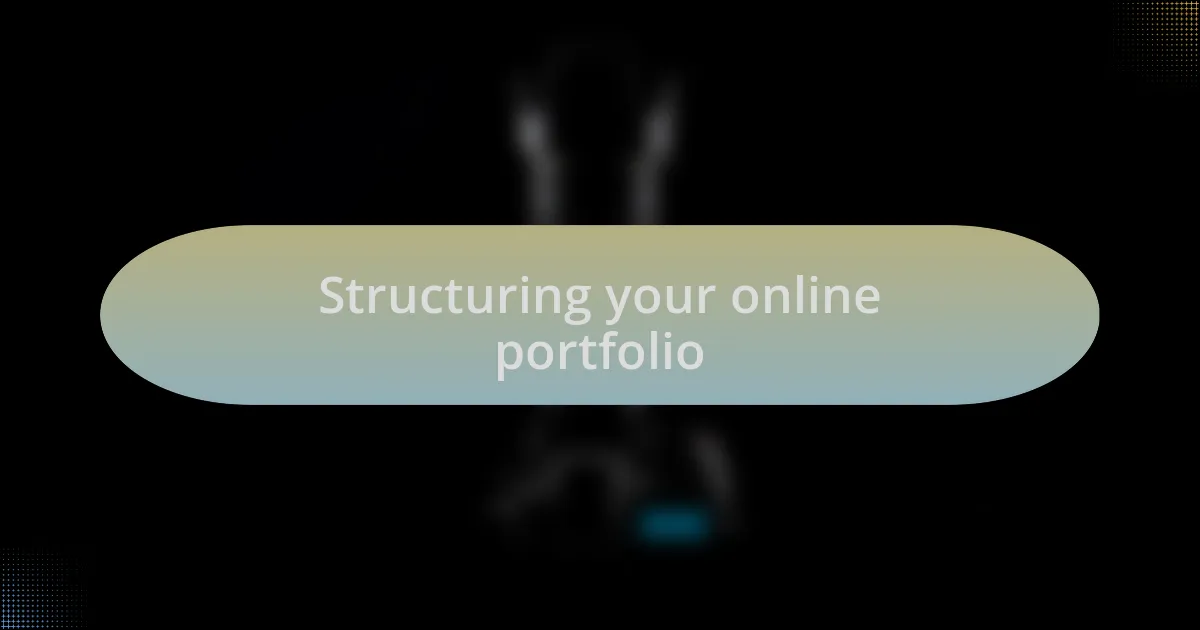
Structuring your online portfolio
When structuring my online portfolio, I quickly realized the importance of layout and flow. I opted for a clean, intuitive design that allowed my images to shine without distractions. Have you ever visited a site where the layout was so cluttered it took away from the photography? I wanted my visitors to experience each piece as it was intended—inviting them into my world without confusion.
I found that categorizing my work by theme helped create a logical structure. For instance, I dedicated sections to portraiture, landscapes, and street photography. Do you think about how your audience navigates your portfolio? One time, a potential client mentioned they appreciated how easily they could explore my different styles, leading them to contact me for a project. It confirmed that thoughtful organization can guide viewers to connect more with your work.
Another aspect I focused on was the storytelling behind my images. While curating a section, I decided to pair select photos with short narratives, allowing me to express emotions tied to each moment. I recall sharing a poignant image of a child lost in thought at a playground, paired with a description of the fleeting innocence of childhood. When was the last time a photograph told you a story? I believe that including these narratives deepens the viewer’s connection to the images and helps my portfolio resonate on a deeper emotional level.
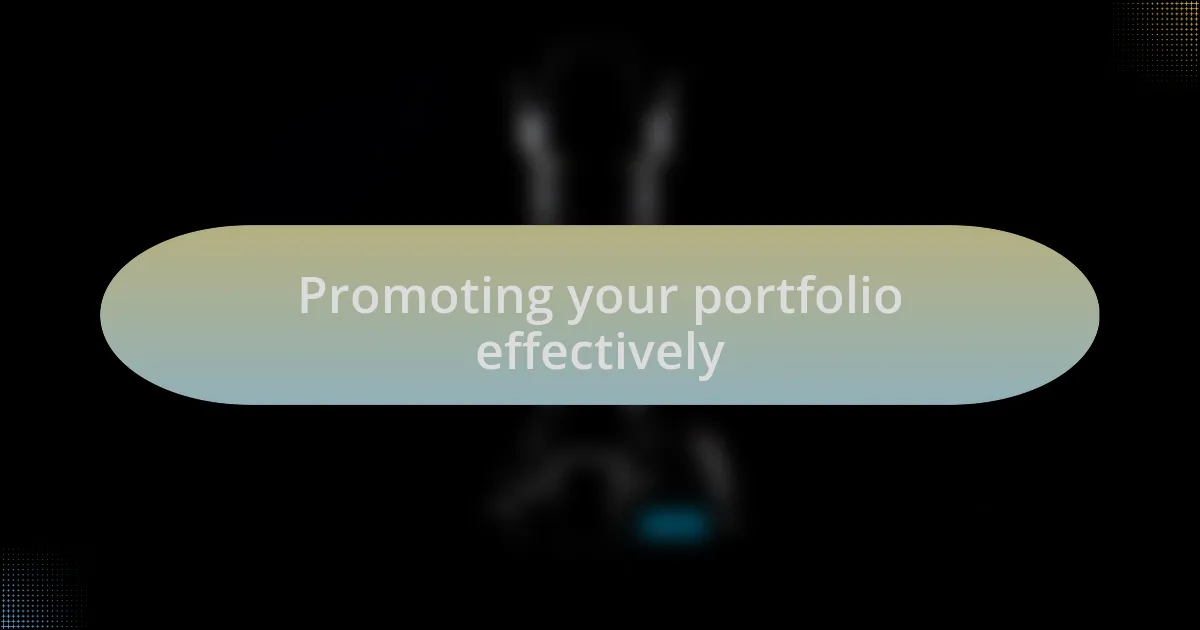
Promoting your portfolio effectively
Promoting your portfolio effectively involves utilizing social media platforms that align with your target audience. I found that sharing behind-the-scenes content generated interest and engagement. Who doesn’t enjoy seeing the creative process? By posting images from shoots or sharing the stories behind each photo, I noticed more people reaching out to learn about my work.
Networking is another key element in promotion. Attending local art shows or photography meetups proved invaluable for me, as it allowed me to connect with fellow photographers and potential clients. I remember one particular event where I struck up a conversation with an art curator who later featured my work in an exhibition. Have you considered how face-to-face interactions could elevate your visibility in the photography community?
Lastly, I believe in the power of collaborating with others. Partnering with local businesses or artists can introduce your portfolio to new audiences. I collaborated with a local boutique for their advertising campaign, which not only showcased my work but also built my credibility in the community. Have you thought about who you could team up with to promote your photography? These strategic alignments can amplify your reach in ways you might not have imagined.
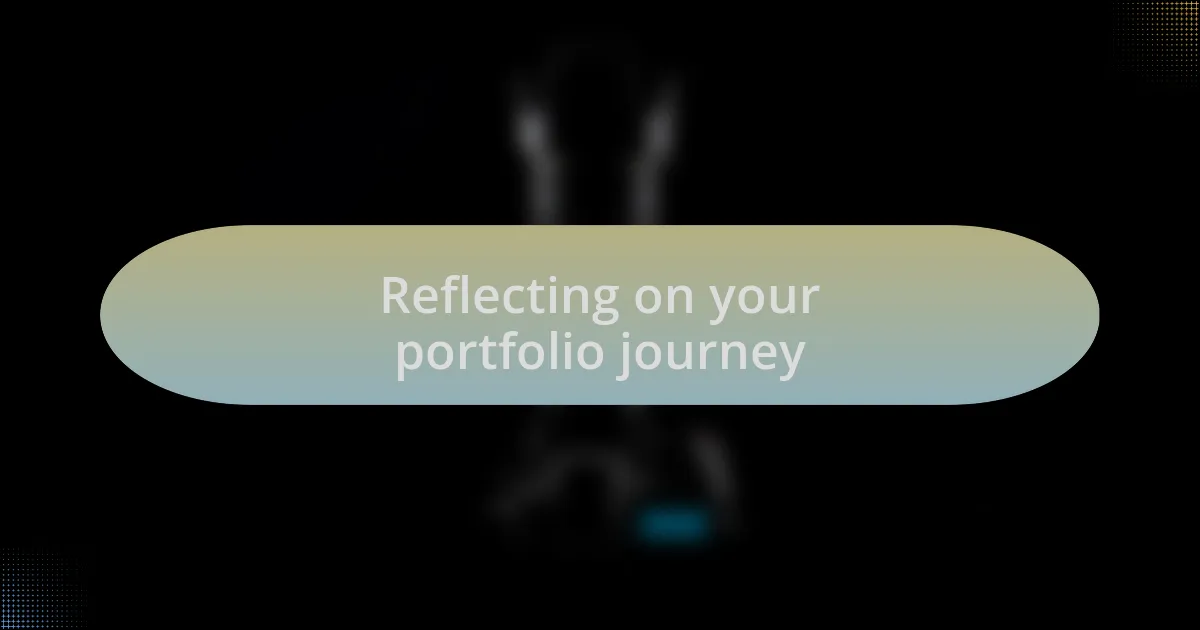
Reflecting on your portfolio journey
Reflecting on my portfolio journey has been both enlightening and rewarding. I often find myself looking back at the first shots I included, realizing how much my style has evolved. It makes me wonder: how often do we recognize the growth we’ve experienced through our creative work?
There were moments where I questioned if my portfolio truly represented who I am as a photographer. I vividly remember a period when I felt stuck, doubting whether the images I was curating told my story effectively. Revisiting those photos helped me see progress, reinforcing the idea that every step, even the frustrating ones, contributed to my artistic identity. Have you taken the time to appreciate the milestones in your photography journey?
As I’ve continued to refine my portfolio, I’ve discovered the importance of introspection. Each image carries a memory, a lesson learned, or a connection made. Reflecting on those experiences allows me to better articulate my vision and purpose. What stories does your portfolio tell about you? It’s essential to recognize that our portfolios aren’t just collections of images; they are chapters of our evolving narrative as photographers.